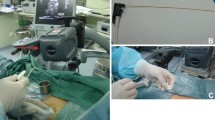Abstract
SonixGPS is a novel real-time ultrasonography navigation technology, which has been demonstrated to promote accuracy of puncture in surgical operations. The aim of this study is to evaluate its application in guiding the puncture during percutaneous nephrolithotomy (PCNL). We retrospectively reviewed our experience in treating a total of 74 patients with complex kidney stones with PCNL, in which puncture in 37 cases were guided by SonixGPS system, while the other 37 by conventional ultrasound. The effectiveness of operation was evaluated in terms of stone clearance rate, operation time, time to successful puncture, number of attempts for successful puncture and hospital stay. The safety of operation was examined by evaluating postoperative complications. Our retrospective review showed that although there were no significant differences in stone clearance rates between the groups, SonixGPS guidance resulted in more puncture accuracy with shorter puncture time and higher successful puncture rate. Under the help of SonixGPS, most patients (92 %) had no or just mild complications, compared to that (73 %) in conventional ultrasound group. Post-operative decrease of hemoglobin in SonixGPS group was 13.79 (7–33) mg/dl, significantly lower than that 20.97 (8–41) mg/dl in conventional ultrasound group. Our experience demonstrates that SonixGPS is superior to conventional ultrasound in guiding the puncture in PCNL for the treatment of complex kidney stone.


Similar content being viewed by others
Abbreviations
- PCNL:
-
Percutaneous nephrolithotomy
- SonixGPS:
-
A real-time ultrasound navigation guidance technology
- SonixGPS-PCNL:
-
Real-time ultrasound navigation technology guided percutaneous nephrolithotomy
- C-PCNL:
-
Conventional ultrasound-guided percutaneous nephrolithotomy
- CT:
-
Computed tomography
- BMI:
-
Body mass index
- KUB:
-
Plain abdominal film (including the kidney, ureter and bladder)
References
Abdelhafez MF, Bedke J, Amend B et al (2012) Minimally invasive percutaneous nephrolitholapaxy (PCNL) as an effective and safe procedure for large renal stones. BJU Int 110:1022–1026
Akman T, Sari E, Binbay M et al (2010) Comparison of outcomes after percutaneous nephrolithotomy of staghorn calculi in those with single and multiple accesses. J Endourol 24:955–960
Ozturk U, Sener NC, Goktug HN, Nalbant I, Gucuk A, Imamoglu MA (2013) Comparison of percutaneous nephrolithotomy, shock wave lithotripsy, and retrograde intrarenal surgery for lower pole renal calculi 10–20 mm. Urol Int 91:345–349
Tyson MD, Humphreys MR (2014) Postoperative complications after percutaneous nephrolithotomy: a contemporary analysis by insurance status in the United States. J Endourol 28:291–297
Tzeng BC, Wang CJ, Huang SW, Chang CH (2011) Doppler ultrasound-guided percutaneous nephrolithotomy: a prospective randomized study. Urology 78:535–539
Xu Y, Wu Z, Yu J et al (2012) Doppler ultrasound guided percutaneous nephrolithotomy with two-step tract dilation for management of complex renal stones. Urology 79:1247–1251
Brinkmann S, Tang R, Sawka A, Vaghadia H (2013) Single-operator real-time ultrasound-guided spinal injection using SonixGPS: a case series. Can J Anaesth 60:896–901
Wong SW, Niazi AU, Chin KJ, Chan VW (2013) Real-time ultrasound guided spinal anesthesia using the SonixGPS needle tracking system: a case report. Can J Anaesth 60:50–53
Brinkmann S, Vaghadia H, Sawka A, Tang R (2013) Methodological considerations of ultrasound-guided spinal anesthesia using the Ultrasonix GPS needle tracking system. Can J Anaesth 60:407–408
Rodrigues PL, Vilaca JL, Oliveira C et al (2013) Collecting system percutaneous access using real-time tracking sensors: first pig model in vivo experience. J Urol 190:1932–1937
Li X, Long Q, Chen X, Dalin H, He H (2014) Real-time ultrasound guided PCNL using a novel SonixGPS needle tracking system. Urolithiasis 42:341–346
Li R, Li T, Qian X, Qi J, Wu D, Liu J (2015) Real-time ultrasonography-guided percutaneous nephrolithotomy using SonixGPS navigation: clinical experience and practice in a single center in China. J Endourol 29:158–161
Rssweiler JJ, Renner C, Eisenberger F (2000) The management of complex renal stone. BJU Int 86:919–928
Kadlec AO, Creco KA, Fridirici ZC, Hart ST, Vellos TG, Tur TM (2013) Comparison of complication rates for unilateral and bilateral percutaneous nephrolithotomy (PCNL) using modified Clavien grading system. BJU Int 111:243–248
Lu MH, Pu XY, Gao X, Zhou XF, Qiu JG, Si-Tu J (2010) A comparative study of clinical value of single B-mode ultrasound guidance and B-mode combined with color Doppler ultrasound guidance in mini-invasive percutaneous nephrolithotomy to decrease hemorrhagic complications. Urology 76:815–820
Yan S, Xiang F, Yongsheng S (2013) Percutaneous nephrolithotomy guided solely by ultrasonography: a 5-year study of > 700 cases. BJU Int 112:965–971
Wang Y, Jiang F, Wang Y et al (2012) Post percutaneous nephrolithotomy septic shock and severe hemorrhage: a study of risk factors. Urol Int 88:307–310
Agarwal M, Agrawal MS, Jaiswal A, Kumar D, Yadav H, Lavania P (2011) Safety and efficacy of ultrasonography as an adjunct to fluoroscopy for renal access in percutaneous nephrolithotomy (PCNL). BJU Int 108:1346–1349
Author information
Authors and Affiliations
Corresponding author
Ethics declarations
Ethical statement
This study has been approved by our institutional review board (IRB) and has been performed in accordance with the ethical standards laid down in the 1964 Declaration of Helsinki and its later amendments.
Conflict of interest
There are no commercial relationships and interests in this manuscript. There is no conflict of interest in this manuscript.
Additional information
X. Li and Q. Long contributed equally to the work.
Rights and permissions
About this article
Cite this article
Li, X., Long, Q., Chen, X. et al. Assessment of the SonixGPS system for its application in real-time ultrasonography navigation-guided percutaneous nephrolithotomy for the treatment of complex kidney stones. Urolithiasis 45, 221–227 (2017). https://doi.org/10.1007/s00240-016-0897-2
Received:
Accepted:
Published:
Issue Date:
DOI: https://doi.org/10.1007/s00240-016-0897-2




